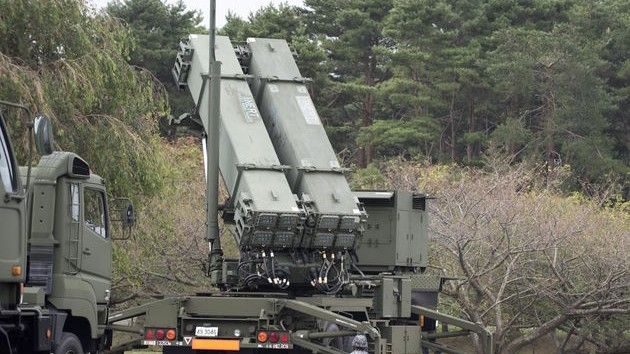Błaszczak: Wisła Agreement Conclusion Within the First Quarter of 2018. Conditions Have Been Set

Terms and conditions of the Agreement concerning the first phase of Wisła programme have been set. Procurement of the IBCS system is still a part of the deal, same applies to the quantity of the PAC-3 MSE effectors. The ultimate price of the whole package is not known as of yet.
We are making good progress and we’re expecting to sign the Wisła programme agreement until the end of the first quarter of 2018. We have managed to reduce the price and accelerate the deliveries. However, the reduced cost does not hamper the assumed combat capabilities to be offered by the system – announced Mariusz Błaszczak, head of the Polish Ministry of Defence. Defence24.pl found out that the contract conditions have been set already.
The new head of the Polish MoD (appointed on 9th January 2018) mentioned the negotiation results on Wednesday via Twitter. Last week Polish delegates visited DC to arrange the conditions of the agreement which would be signed with the US Government as a part of the FMS programme - as Defence24.pl found out. Poland is willing to procure the Raytheon’s Patriot solution as a part of its Wisła air/missile defence programme. The said system would be coupled with the Northrop Grumman’s IBCS command system.
Good news regarding the Wisła programme. We have managed to reduce the price and accelerate the deliveries. However, the reduced cost does not hamper the assumed combat capabilities to be offered by the system. We’re hoping to sign the agreement at the end of the first quarter of 2018.
Defence24.pl found out that the line-by-line review process has also come to an end. The agreement is now waiting for full compilation and it is to be ready before the end of March. However, without the contract in place, the Ministry refrains from mentioning the price.
Defence24.pl’s unofficial sources suggest that no hampering of the combat capabilities of the Wisła system would occur, in relation to the notification issued by the Department of State for the US Congress at the end of 2017. This concerns both the IBCS solution, as well as the latest PAC-3 MSE missiles, 208 of which are listed within the release (plus 11 for testing purposes).
The delivery process is also going to be accelerated, in comparison with the original Polish schedule, with the first battery arriving before the end of 2022, and the second one following in 2024.
In Mid-November 2017 the US State Department issued a consent, regarding procurement of four Patriot fire units integrated with the IBCS system and adopted to be plugged into the IAMD architecture. The package includes: 16 launchers, 208 PAC-3 MSE effectors, with 11 to be used for testing, as well as IBCS suite elements, including 14 Engagement Operation Centres, adaptation packages for launchers and radars and IFCN comms suite elements.
The maximum price of the package amounted up to USD 10.5 billion, according to DSCA. This is an amount which is higher than the Polish budget that would cover two phases of the Wisła programme. The former Deputy Defence Minister recently told us that the proposed 10.5 billion dollar pricetag is unacceptable, since Poland, starting from the very beginning, was clearly defining the budget for the whole programme. Kownacki added that the communication with DC shows that the US exhibits good will. Even though the talks are tough, as Kownacki said, the Polish official was hopefully looking towards finalization of the first stage of the Wisła programme.
Following the issuance of draft LOA, talks began. The negotiation took on a form of a “line-by-line review”, referring to the individual provisions contained within the agreement.
In mid-January “Dziennik Gazeta Prawna” announced that Poland received a new offer, with a value of less than 7 billion dollars. However, this was not the final proposal, with the “line by line review” in progress. On 22nd January delegates if the Armament Inspectorate of the Polish MoD were sent to the US.
Poland is the first country that has been authorized to acquire the IBCS system. This is happening as a part of the “yockey waiver” procedure, allowing the country to access armament that is not being series manufactured now, which usually delimits the available scope of FMS procurement. Kownacki, back in December, mentioned that IBCS would be integrated with the Narew solution (SHORAD), in case of which the Polish industry would be acting as the prime contractor.
Wisła programme has been divided into two stages. The currently negotiated intergovernmental contract concerns procurement of two batteries (four fire units) and certain elements of the comprehensive medium range air defence solution.
360 degrees coverage radar and SkyCeptor missiles are to be the cornerstone of the second stage of acquisition. Both of the aforesaid products are expected to be manufactured domestically in Poland. Tarik Reyes, Vice President, Missile Defense and Protective Systems at Northrop Grumman, told us that Wisła’s second stage would also see the Polish sensors being integrated with the system. Reyes suggested that some production capacity would be transferred during the first phase, allowing for the integration to take place during the second stage.
Following the second stage, eight Wisła batteries will be available in Poland. Nonetheless, completion of that phase is dependent on separate factors, including the integration of SkyCeptor and procurement and modernization programmes undertaken in the US. The Americans have not made final selection with regards to the future LTAMDS 360 degrees coverage radar as of yet. The Polish MoD would be driven to use a solution compatible with the one selected by the US Army, not to face extra costs entailed by implementation and operational use of a system which would be unique. For that reason, signing an agreement related to phase II shall not be expected in 2018.
Rafał Lesiecki and Jakub Palowski
